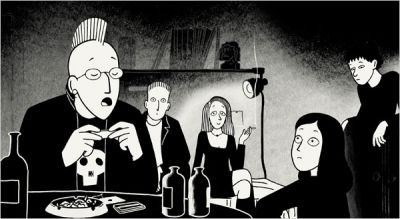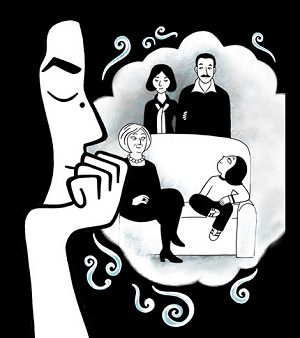Serendip is an independent site partnering with faculty at multiple colleges and universities around the world. Happy exploring!
Notes Towards Day 21: Growing Up Graphic
I. Coursekeeping
notetaking by skindeep
watching Persepolis the movie for Tuesday's class
(shift in mode: giving you some background/guidance for watching)
According to Hilary Chute, "The Texture of Retracing in Marjane Satrapi's Persepolis." Women's Studies Quarterly 36, 1&2 (Spring/Summer 2008): 92-110,
"the film version--which was written and directed by Satrapi, and to which she retains all creative rights--won the Jury Prize at the Cannes film Festival .... that Satrapi, a first-time director with no film experience ... demanded full creative control, demonstrates how one woman brought the auteur-driven model of the literary graphic narrative --and life narrative--to a different medium (one that happens to be the dominant representational idiom of our time).
She insisted on an artisanal mode of production, so her team hand-traced images on paper -- an art that has long been obsolete in animation, replaced by computer technology. She also insisted -- as for the graphic narrative -- on black and white, a rarity for contemporary animated films. But most strikingly, Persepolis the film, as with the book, insists in its mode of production on what I call the texture of retracing .... Satrapi acted out the physical gestures for each scene of the film to give her animators a physical reference ("I play all the roles. Even the dog"....). Satrapi, in the expanded field of production afforded by the film, yet inserts her literal, physical body into each frame ... through her own physical act of repetition.
Really great comparative exercise, because the text and
the film are so alike, guided by the same creative mind.
HOW DO THEY DIFFER? HOW DO THE GENRES DIFFER? HOW DOES YOUR EXPERIENCE OF EACH DIFFER?
"Before it's projected ... film is just a very
very very very slow comic" (McCloud).
And afterwards.....? What difference does the MOVEMENT make?

Pair up w/ someone across the room....
I was asking, as we ended discussion on Tuesday, about happens to our close readings, if we place the form of Satrapi's work in a long historical context; consider, for example "the swarming effect" of
* illustrated Bibles
* Hieronymus Bosch
* Pieter Brueghel
cartoons that incorporated verbal content, such as Hogath's 18th c. sequence, The Harlot's Progress (punctual, framed moments in an ongoing narrative);
two additional sources identified by Sartrapi herself:
in Persian miniatures ("the drawing itself is very simple," eschewing perspective); see Bihzad on "trying to paint the world as God would see it and not as we, humans, do."
avant-garde, black-and-white, expressionistic films like
Murnau's vampire fantasy Nosferatu (1922).
What do these comparisons highlight about what Sartrapi is doing?
Begin "drafting," w/ your partner, an essay on the "evolution of autographics." Which of these GENERIC FORMS (note that none of them are autobiographic) might operate interestingly as one of Sartrapi's ancestors? Why? What echoes do you see between her and the genre you selected as her predecessor? How do you see her intervening in and altering that generic tradition?
Hilary Chute, "The Texture of Retracing in Marjane Satrapi's Persepolis." Women's Studies Quarterly 36, 1&2 (Spring/
Summer 2008): 92-110.
Some of today's most riveting feminist cultural production is in the form of accessible yet edgy graphic narratives.
"graphic narratives"... claim their own historicity -- even as they work to destabilize standard narratives of history .... bridging wartime-focused testimonies and child-oriented testimonies ...
Persepolis is about the ethical verbal and visual practice of "not forgetting" ... modeling a feminist methodology in its form, in the complex visual dimension of its author narrating herself on the page as a multiple subject.

Is/how is Marji "doubled" in this form? Does she often think one thing and say another? How is her "doubleness" represented?


